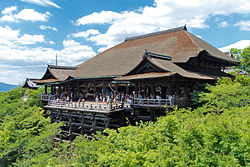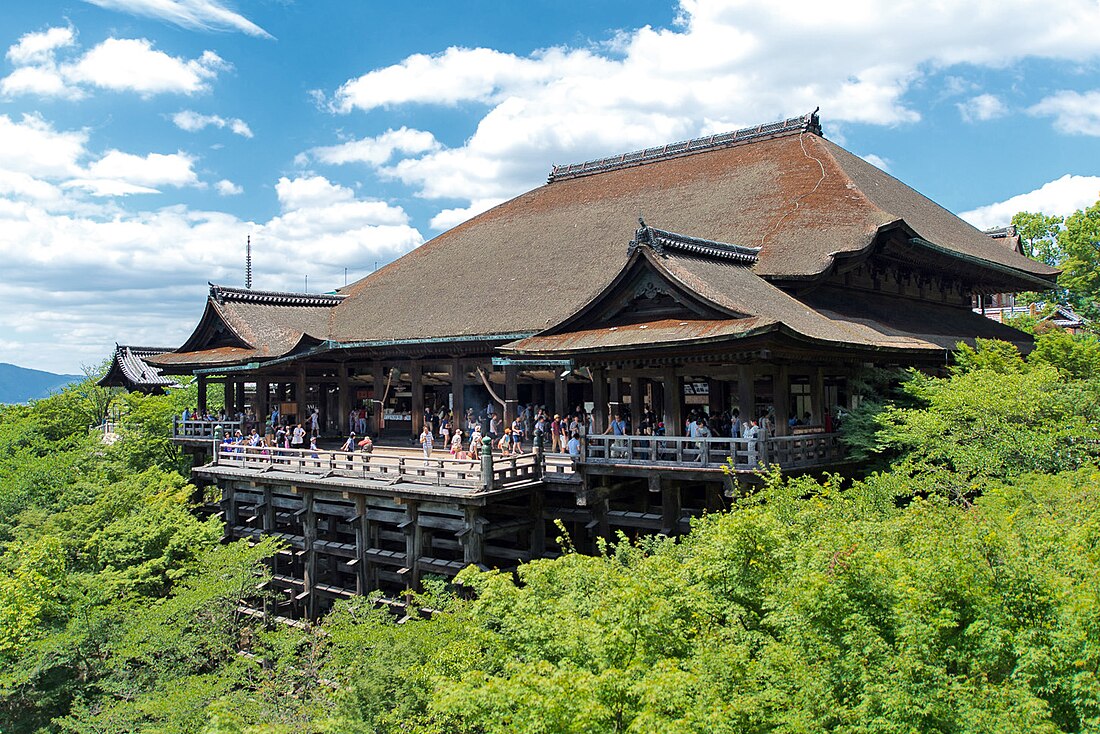Kiyomizu-dera
Buddhist temple in Kyoto, Japan From Wikipedia, the free encyclopedia
Kiyomizu-dera (Japanese: 清水寺, lit. 'Pure Water Monastery') is a Buddhist temple located in eastern Kyoto, Japan. The temple is part of the Historic Monuments of Ancient Kyoto UNESCO World Heritage Site.[1]
| Kiyomizu-dera | |
|---|---|
清水寺 | |
 | |
| Religion | |
| Affiliation | Buddhism |
| Sect | Kita-Hossō |
| Deity | Kannon |
| Location | |
| Location | Higashiyama-ku, Kyoto |
| Country | Japan |
| Geographic coordinates | 34°59′42″N 135°47′06″E |
| Architecture | |
| Founder | Sakanoue no Tamuramaro, reconstructed by Tokugawa Iemitsu |
| Date established | 778 |
| Completed | 1633 (reconstruction) |
| Website | |
| www | |
| Kiyomizu-dera | |||||
|---|---|---|---|---|---|
"Kiyomizu-dera" in kanji | |||||
| Japanese name | |||||
| Kanji | 清水寺 | ||||
| Hiragana | きよみずでら | ||||
| |||||
History
Summarize
Perspective

The temple was established in 778, during the late Nara period, by Enchin Shonin, who was a priest from Nara (the capital of Japan from 710 to 784). He is said to have received a vision telling him to construct the temple next to the Otowa spring.[2][3]
In 798, the shogun Sakanoue Tamuramaro improved the site by including a large hall that was reassembled from the palace of Emperor Kammu (r. 781–806). The emperor had left Nara to escape the strong influence that the Buddhist monasteries had on the government there. During this period there was a strong rivalry between the Kofuku-ji and the Kiyomizu-dera temples, and both had influence around the region.[2]
Many of the temple's present buildings were constructed in 1633 on the orders of the shogun Tokugawa Iemitsu.[4] There is not a single nail used in the entire structure. It takes its name from the waterfall within the complex, which runs off the nearby hills. Kiyomizu means "pure water".[5][6]
It was originally affiliated with the old and influential Hossō sect, dating from Nara times.[3] However, in 1965 it severed that affiliation, and its present custodians call themselves members of their own Kita-Hossō (Northern Hossō) sect.[7]
Present
The expression "to jump off the stage at Kiyomizu" is the Japanese equivalent of the English expression "to take the plunge".[6] This refers to an Edo-period tradition that held that if one survived a 13-meter (43-foot) jump from the stage, one's wish would be granted. During the Edo period, 234 jumps were recorded, and of the jumpers, 85.4 per cent survived.[6] The practice was prohibited in 1872.[6]
The temple complex includes several other shrines, among them the Jishu Shrine, dedicated to Ōkuninushi, a god of love and "good matches".[5] Jishu Shrine possesses a pair of "love stones" placed 10 meters (30 feet) apart,[8] which lonely visitors can try to walk between with their eyes closed. Success in reaching the other stone with their eyes closed implies that the pilgrim will find true love.[9]
The complex also offers various talismans, incense, and omikuji (paper fortunes). The site is particularly popular during festivals, especially at New Year's and during obon in the summer, when additional booths fill the grounds selling traditional holiday foodstuffs and souvenirs.[10]
In 2007, Kiyomizu-dera was one of 21 finalists for the New Seven Wonders of the World,[11] but was not picked as one of the seven winning sites. The temple was covered entirely by semi-transparent scaffolding while it underwent restoration works in preparation for the 2020 Olympics.
Architecture
Kiyomizu-dera is located in the foothills of Mount Otowa, part of the Higashiyama mountain range that dominates eastern Kyoto. The main hall has a large veranda, supported by tall pillars using kakezukuri, that juts out over the hillside and offers views of the city. Large verandas and main halls were constructed at many popular sites during the Edo period to accommodate large numbers of pilgrims.[12]
Beneath the main hall is the Otowa waterfall, where three channels of water fall into a pond. Visitors can catch and drink the water, which is believed to have wish-granting powers. There is also the Tainai Meguri, a dark tunnel said to represent the womb of Daizuiku Bosatsu (the bodhisattva Mahāpratisarā).[13][14]
Gallery
- Kiyomizu-dera in autumn
- Kiyomizu-dera in winter
- Statuettes of Ksitigarbha (or Jizō) en masse
- Otowa-no-taki, the waterfall where visitors drink for health, longevity, and success in studies
- Kiyomizu-dera, Illuminated
- Dougong architectural element, Kiyomizu-dera
- Dragon sculpture at Kiyomizu-dera
- Right to left: Kaisan-do (Founder's Hall), Kyo-do (Sutra Hall) and Sanju-no-to (Three storied Pagoda)
- View of Kyoto and Niōmon from Kiyomizu-dera
- Kiyomizu-dera
See also
References
Sources
External links
Wikiwand - on
Seamless Wikipedia browsing. On steroids.













